Elevate Your Marketing Strategy Using 5 Key Google Analytics Reports
To craft impactful marketing strategies that resonate with audience behaviour, it is essential to leverage Google Analytics 4 (GA4). While the interface and terminology of GA4 may initially appear daunting to beginners, attaining a solid grasp of its capabilities can reveal valuable insights into customer interactions. By mastering the features and data provided by GA4, you can uncover crucial insights into your customers’ preferences and behaviours, empowering you to effectively refine your marketing efforts. Let’s delve into five critical GA4 reports that will significantly enhance your marketing strategies and result in improved outcomes.
1. Traffic Acquisition Report: Uncover Your Most Effective Traffic Sources
Have you ever pondered where your website traffic originates? The Traffic Acquisition report serves as an invaluable tool for answering this vital question. This insightful report breaks down the various channels that attract visitors to your site, unveiling essential marketing channels such as organic search, paid advertising, social media, and referrals. Gaining a comprehensive understanding of these channels is critical for any marketing strategy aiming to enhance visibility and elevate conversion rates.
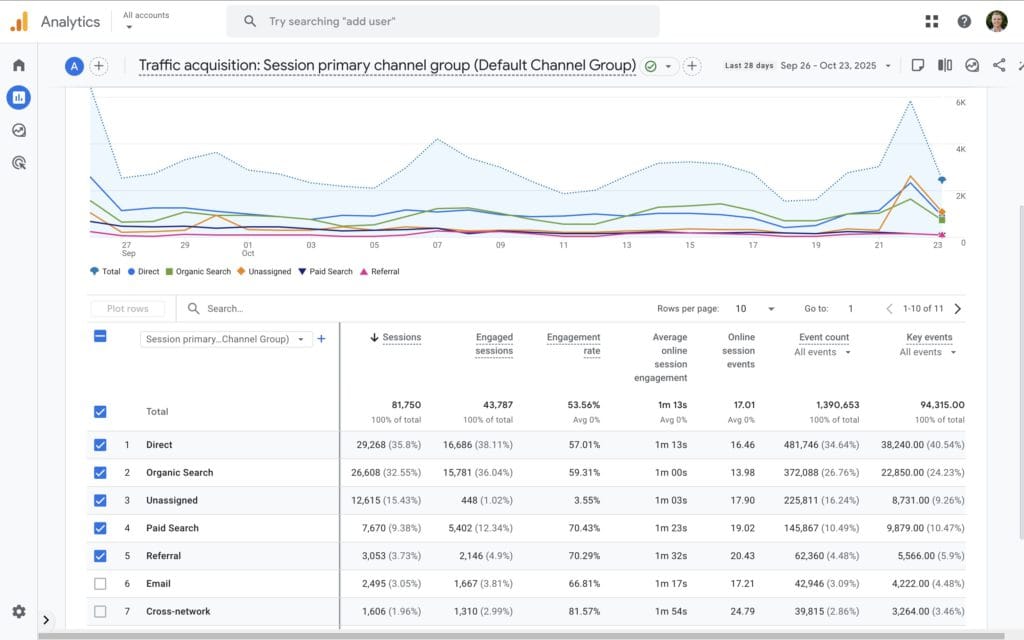
How to Effectively Leverage the Traffic Acquisition Report:
- Identify Your Top-Performing Channels: Conduct a thorough analysis to pinpoint which platforms generate the highest volume of visitors to your site. If organic search emerges as a leading channel, consider increasing your investment in SEO strategies to capitalise on that traffic.
- Assess Traffic Quality: Look beyond mere numbers; evaluate metrics such as sessions per user and average engagement time to gain a clearer understanding of genuine visitor interest and intent.
- Optimise Your Marketing Budget: Strategically allocate your budget to the channels that not only attract visitors but also engage them effectively, ensuring a higher return on investment.
By understanding where your audience comes from, you can realign your marketing focus to prioritise the channels that yield the best results. The report automatically highlights various methods through which users discover your website; however, enhancing its accuracy by tagging your inbound marketing campaigns is crucial. This customisation is particularly beneficial when sending newsletters or executing advertising campaigns aimed at driving traffic to your site.
Enhance Your Google Analytics Tracking with Campaign Tagging URLs
Campaign-tagged URLs are specially designed links to your website that incorporate additional tracking information known as query parameters. These parameters allow Google Analytics to monitor your marketing efforts with unmatched precision. By appending these parameters to your URLs, you gain access to detailed insights regarding how visitors navigate to your site, providing data that extends beyond the default reports.
What Are the Key Benefits of Using Campaign Tagging URLs?
- Track Individual Marketing Campaigns: These URLs enable you to identify which specific marketing campaigns successfully drive traffic to your website, allowing for targeted adjustments.
- Understand Your Traffic Origins: Gain insights into where your visitors come from, whether it be a newsletter, social media post, or paid advertisement, giving you a clearer picture of your marketing effectiveness.
- Evaluate Campaign Effectiveness: By analysing data from tagged URLs, you can pinpoint your most successful campaigns and adapt your strategy accordingly for better results.
How Do Campaign Tagging URLs Enhance Your Acquisition Reports?
By default, Google Analytics categorises traffic sources into broad categories such as organic search, direct, referral, and organic social. While this classification provides a foundational understanding, it often lacks the detail necessary to glean insights into specific campaigns or links. Campaign tagging URLs offer a more granular view, allowing for enhanced tracking and analysis, thus improving your overall understanding of visitor behaviour.
How to Implement Campaign Tagging in Your URLs for Best Results?
To effectively utilise campaign-tagged URLs, you must append specific parameters to your inbound links. The essential parameters include:
- utm_source – identifies the source of your traffic, such as a newsletter, Facebook, or Google, helping you track where your audience originates.
- utm_medium – specifies the marketing medium, whether it be email, social media, or cost-per-click (CPC), providing clarity on your marketing channels.
- utm_campaign – denotes the specific campaign name, such as ‘spring sale' or ‘product launch', making it easier to assess campaign performance.
- utm_term (optional) – primarily used for paid search campaigns to identify specific keywords, enhancing your ability to track keyword performance.
- utm_content (optional) – differentiates similar content or links within the same advertisement or campaign, allowing for more nuanced tracking.
For example, here is an illustration of a Tagged URL:

When a user clicks this tagged link, Google Analytics records the parameters, enabling you to ascertain that the visitor originated from your “spring sale” campaign via an email newsletter. By refining your inbound links with campaign tags, you can accurately track how users discover your website and their levels of engagement, thereby optimising your marketing strategies.
In addition to creating campaign-tagged URLs, linking your Google Ads account with Google Analytics offers further advantages. You can view a tutorial video to guide you through this process:
2. Engagement Reports: Gain Insights into User Interaction on Your Website
Attracting traffic to your site is merely the beginning. The Engagement Reports provide vital insights into user behaviour once they arrive on your site. Do they stay and explore your content, or do they exit quickly? Which pages captivate their attention the most?
Within the Engagement section, the Pages and Screens report aggregates data on all the pages users have accessed on your website. This report is instrumental in pinpointing your most and least engaging content. Key metrics to monitor include:
- Views: The total number of views your pages have received, enabling you to quickly identify content that resonates well with users.
- Views Per Active User: This metric reveals which content users find compelling enough to revisit, indicating sustained interest or value in your offerings.
- Key Events: Track significant actions on specific pages, such as purchases, sign-ups, or other conversions. Configuring key events allows you to evaluate how effectively particular pages drive user actions and contribute to your business goals.
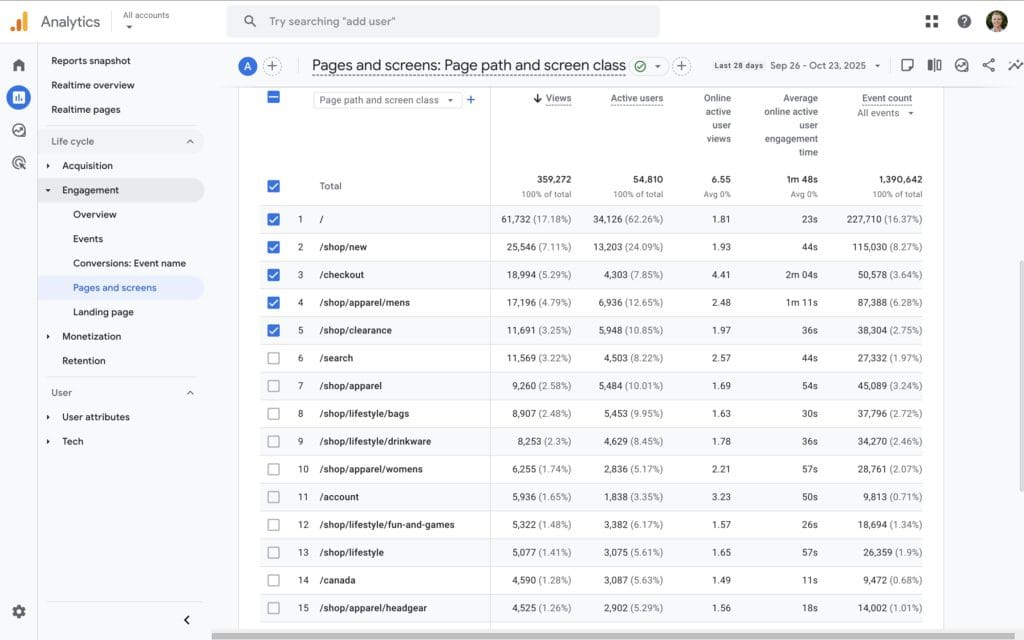
Utilise These Insights to Enhance Your Website:
- Enhance High-Performing Content: If certain blog posts or product pages are excelling, consider creating additional similar content to capitalise on that interest and drive more traffic.
- Improve Low-Engagement Pages: Identify pages with high bounce rates and implement necessary adjustments to boost engagement, such as clearer calls to action or more captivating visuals.
- Personalise User Experience: Ensure that your website navigation is intuitive and that the content is relevant to encourage visitors to explore further and engage with your site.
Prioritising user engagement is paramount; your goal is not solely to increase page views but to forge connections that convert visitors into leads and loyal customers for your business.
3. Funnel Exploration Report: Visualise and Enhance the User Journey
Understanding how users navigate through your website is vital for boosting conversion rates. The Funnel Exploration report in GA4 allows you to visualise the steps users take to achieve specific goals, such as completing a purchase or subscribing to a newsletter. This report helps you identify where users abandon the conversion process, providing insights on how to enhance each stage to improve the user experience.
Steps to Create a Funnel Exploration Report in GA4:
- Navigate to the ‘Explore’ section of GA4.
- Click ‘Blank’ to initiate a new report.
- Select ‘Funnel Exploration’ from the drop-down menu under ‘Technique’.
Step 2: Define Your Funnel Steps
- Click the pencil icon next to ‘Steps’ to outline your funnel.
- Add a step for each stage in your user journey and assign it a clear name (e.g., ‘Visited Homepage’, ‘Viewed Product’, ‘Added to Cart’, ‘Completed Purchase’).
- For each step, select the event or page view that corresponds to that action.
For example:
- Visited Homepage: Event name equals ‘page_view’ where page path equals ‘/’.
- Viewed Product: Event name equals ‘view_item’.
- Added to Cart: Event name equals ‘add_to_cart’.
- Completed Purchase: Event name equals ‘purchase’.
- After defining all steps, click ‘Apply’.
Step 3: Customise Your Funnel (Optional)
- Choose between an ‘Open Funnel,’ allowing users to enter at any step, or a ‘Closed Funnel,’ where users must start from the first step for a streamlined experience.
- Set an optional timeframe for how long users have to complete the funnel, creating urgency for conversions.
- Add filters to focus on specific user criteria if necessary, ensuring that you analyse relevant data.
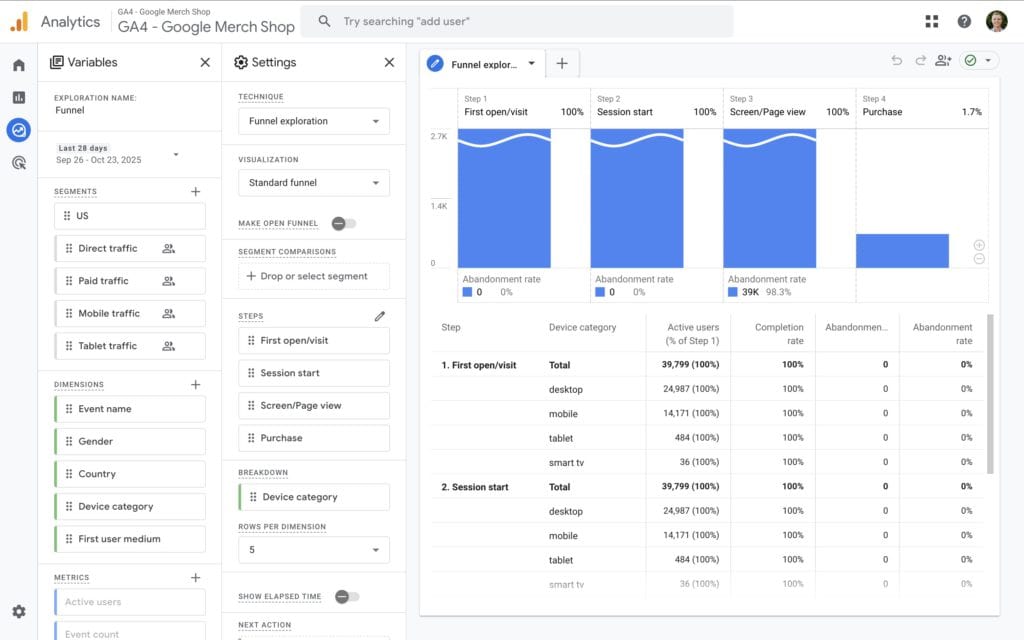
Maximise the Value of This Report By:
- Optimising Conversion Steps: Analyse each stage of the funnel to identify opportunities for improvement. If a significant number of users exit at a specific step, consider simplifying the process or providing additional guidance to enhance their experience.
- Enhancing User Experience: Leverage insights from the funnel report to create a more intuitive user journey. This may involve redesigning pages, improving load times, or refining calls to action to better engage users.
- Testing and Iterating: Conduct A/B tests throughout funnel stages to identify which changes yield higher conversion rates. Continuous testing allows you to refine the process over time and make data-driven adjustments.
- Personalising Content: Tailor the user experience based on segment behaviour. For instance, if mobile users exit at a specific point, optimise that step for mobile devices to enhance their journey.
Utilising the Funnel Exploration report enables you to create a streamlined and efficient path to conversion. By identifying and addressing weaknesses within your funnels, you can refine the process and effectively guide users towards your desired outcomes.
4. Demographic Details Report: Gain In-Depth Insights into Your Audience
The Demographic Details report offers invaluable insights into your audience's age, gender, location, and interests. This information is essential for helping you tailor your content and marketing campaigns to connect more effectively with your audience, ultimately driving higher engagement and conversion rates.
Key Insights from the Demographic Report:
- Age and Gender Analysis: Discover the age ranges and gender distribution of your audience to tailor your messaging to align better with their preferences.
- Geographic Distribution: Identify the geographic locations of your users to refine regional marketing efforts and time your campaigns more effectively for maximum impact.
- Interests and Affinity Categories: Understand your users' interests beyond your website to create more engaging and relevant content that resonates with them.
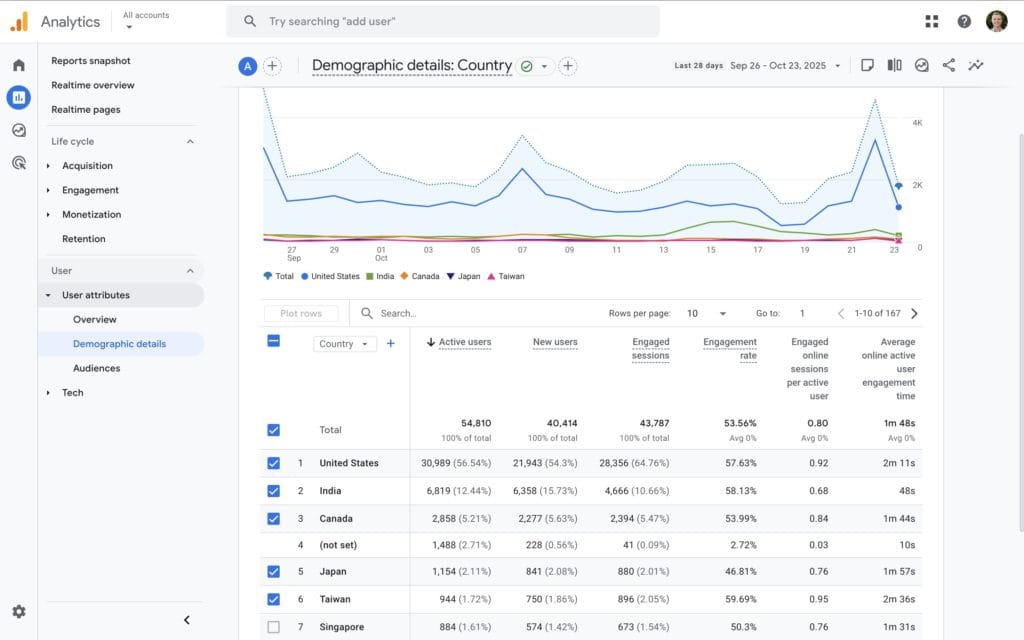
Effective Strategies Derived from Demographic Insights:
- Personalise Your Content: Craft your content and marketing messages to align seamlessly with the preferences of your primary demographic segments, ensuring relevance and engagement.
- Implement Targeted Advertising: Utilise demographic data to refine your ad targeting, ensuring your promotions reach the most receptive audience for better conversion rates.
- Expand Your Market Reach: Identify underrepresented demographics that present growth opportunities and devise strategies to engage these potential users effectively.
By focusing on demographic insights, you can create marketing campaigns that are more effective and relevant, connecting with your audience's specific needs and preferences to drive better results.
5. Monetization Report: Uncover Critical Insights into Your Revenue Streams
For websites that generate revenue, the Monetization reports are indispensable. These reports provide a comprehensive overview of how users contribute to your financial success, enabling you to make informed decisions regarding your marketing strategies and revenue generation efforts.
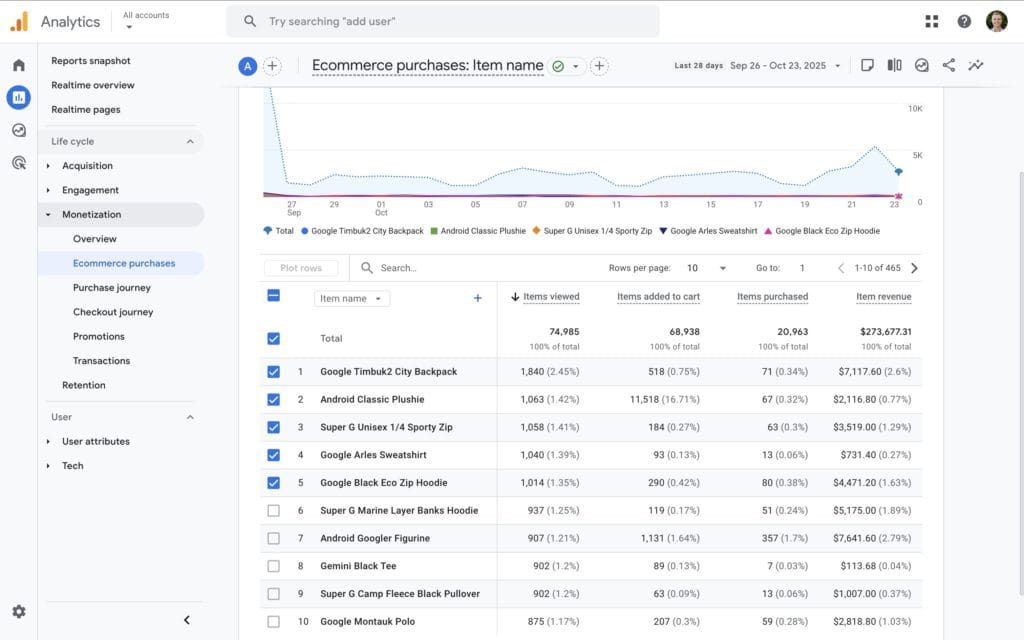
Essential Metrics to Monitor for Revenue Insights:
- Total Revenue: The cumulative income generated over a specific period, providing a clear picture of your financial performance.
- Average Purchase Revenue: The average revenue generated per transaction, helping you assess pricing strategies and sales performance.
- Purchases: Track the frequency and types of products or services sold to understand customer preferences and inform inventory decisions.
Utilise This Data to Enhance Your Revenue Streams:
- Identify Your Best-Selling Products: Concentrate your marketing efforts on products that generate the highest revenue to maximise profitability and drive sales.
- Enhance Product Promotion: Increase the visibility and attractiveness of your products to drive sales and boost overall revenue through targeted marketing strategies.
- Leverage Upselling and Cross-Selling Opportunities: Use purchasing data to recommend complementary products, thereby increasing the average order value for your business and enhancing customer satisfaction.
A thorough understanding of your monetisation metrics empowers you to make informed decisions that significantly enhance profitability and drive sustainable business growth.
Take Action to Master Google Analytics for Enhanced Marketing Success
By familiarising yourself with these five pivotal GA4 reports, you are laying the groundwork for marketing success rooted in data-driven insights. When you feel ready to deepen your expertise in Google Analytics, consider enrolling in a Google Analytics 4 Course to learn how to leverage these reports effectively and maximise the utility of this essential business tool.
It is important to remember that successful marketing is not solely about attracting visitors; it also involves understanding their needs and behaviours. Utilise the reports discussed above to gain deeper insights into your audience, refine your strategies, and witness your marketing initiatives thrive.
The post 5 Google Analytics Reports Every Marketer Should Know About appeared first on Ezi Gold.
The Article Google Analytics Reports Every Marketer Must Know Was Found On https://limitsofstrategy.com
The Article Essential Google Analytics Reports for Every Marketer First Appeared ON
: https://ad4sc.com

No responses yet